Stanley Village -
Part 4 - St Andrew's Church
w/e 29 October 2006
All
this week's pictures were taken with a Kodak DX6490

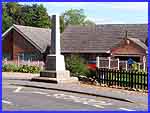 In
our fourth part of our monthly series about Stanley Village we
move a little way from the War Memorial to concentrate on Stanley
Church which is dedicated to St Andrew. The present church was
rebuilt in 1200 and is mentioned in the Taxation Roll of 1291
as the Chapel Of Stanley. It is thought that the church was built
on the site of a Saxon foundation. Prior to the Reformation the
church at Stanley belonged to Dale Abbey and it is said that
some stonework from the Abbey, like many other buildings nearby,
is now incorporated in the church. It then passed to the Powtrell
family and later it became a chapel-of-ease to Spondon, remaining
so until 1852. In
our fourth part of our monthly series about Stanley Village we
move a little way from the War Memorial to concentrate on Stanley
Church which is dedicated to St Andrew. The present church was
rebuilt in 1200 and is mentioned in the Taxation Roll of 1291
as the Chapel Of Stanley. It is thought that the church was built
on the site of a Saxon foundation. Prior to the Reformation the
church at Stanley belonged to Dale Abbey and it is said that
some stonework from the Abbey, like many other buildings nearby,
is now incorporated in the church. It then passed to the Powtrell
family and later it became a chapel-of-ease to Spondon, remaining
so until 1852.
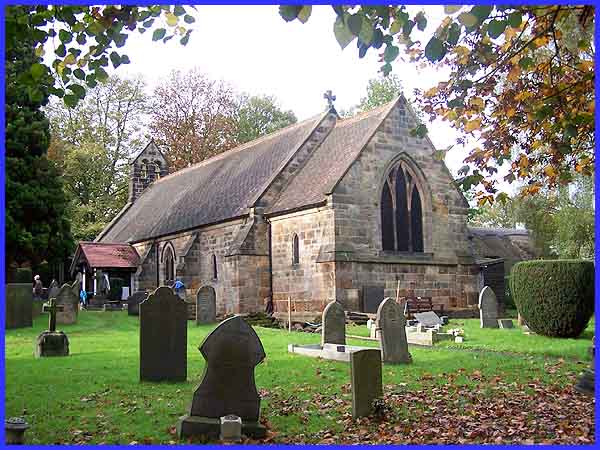
 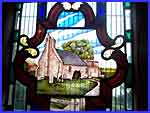 Stanley
became a separate parish in 1852 and the church was restored
and enlarged in 1875 although it retains some Norman features.
A stained glass window (left) in memory of Frederick Canner (died
1914) and Ethel Canner (1964) depicts several emblems and symbols
synonymous with the area including Dale Windmill, a wheatsheaf
to mark the agricultural links and headstocks to signify the
former local mining industry. It also features a representation
of the church in 1875 (right). Stanley
became a separate parish in 1852 and the church was restored
and enlarged in 1875 although it retains some Norman features.
A stained glass window (left) in memory of Frederick Canner (died
1914) and Ethel Canner (1964) depicts several emblems and symbols
synonymous with the area including Dale Windmill, a wheatsheaf
to mark the agricultural links and headstocks to signify the
former local mining industry. It also features a representation
of the church in 1875 (right).
|
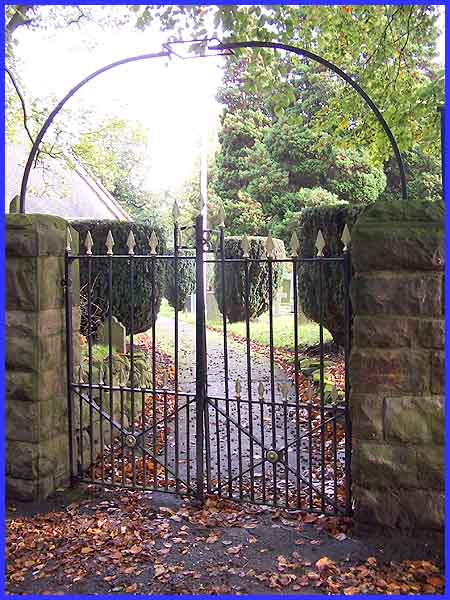
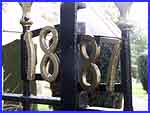 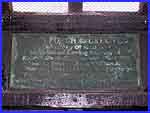 In 1887, Queen Victoria's Golden Jubilee,
the church gates were erected and the year (left) was recorded
in the design of the gates to mark the occasion. Another event
recorded in the structure of the church is the porch which was
erected 'To the Glory of God and in Loving Memory' of six men
of the village who gave their lives in the Great War 1914-1918.
A plaque in the porch (right) lists their names. In 1887, Queen Victoria's Golden Jubilee,
the church gates were erected and the year (left) was recorded
in the design of the gates to mark the occasion. Another event
recorded in the structure of the church is the porch which was
erected 'To the Glory of God and in Loving Memory' of six men
of the village who gave their lives in the Great War 1914-1918.
A plaque in the porch (right) lists their names.
|
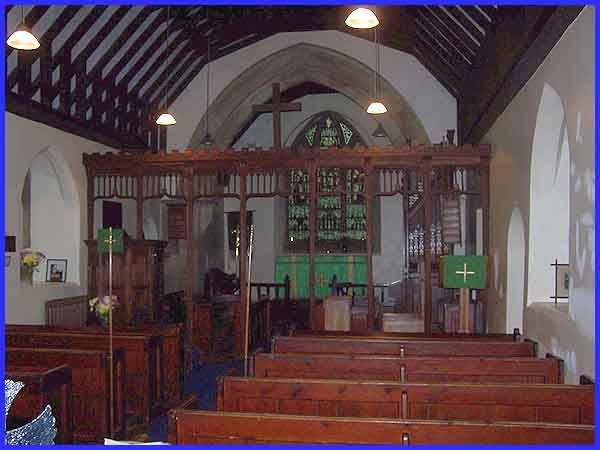
 Kelly's
Directory published in 1891 describes the church of St Andrew
as a "small and ancient edifice of stone, consisting of
chancel, nave, south porch, vestry and a turret on the western
gable containing two bells dated 1661". It also mentions
the carved oak pulpit which dates from Jacobean times which normally
refers to the period of the reign of James I from 1603 until
1625. The pulpit (see small image left) can still be seen in
the church today together with an octagonal font from the fourteenth
century. It is also recorded that the church provided sanctuary
to a mediaeval murderer. The man who sought sanctuary, William
Welshman could not be turned out of the building for forty days. Kelly's
Directory published in 1891 describes the church of St Andrew
as a "small and ancient edifice of stone, consisting of
chancel, nave, south porch, vestry and a turret on the western
gable containing two bells dated 1661". It also mentions
the carved oak pulpit which dates from Jacobean times which normally
refers to the period of the reign of James I from 1603 until
1625. The pulpit (see small image left) can still be seen in
the church today together with an octagonal font from the fourteenth
century. It is also recorded that the church provided sanctuary
to a mediaeval murderer. The man who sought sanctuary, William
Welshman could not be turned out of the building for forty days.
|
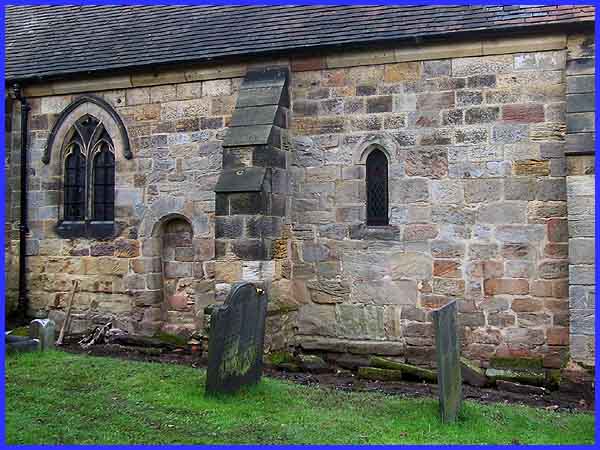
In 1950 renovation work on the north side of the church uncovered
a tombstone under the floor which is thought to be that of Sir
John Bentley and his family dating from the 1600s. Currently
work is being undertaken on the south side of the church to relay
and repair paths. No similar discoveries have been made (so far)
but it is here that we can see the small round-headed priest's
doorway that although now blocked up, is a fine example of Norman
architecture. To the right some of the buttresses and the small
lancet window date from the thirteenth century. Notice the lintel
above the lancet window is carved from one block of stone as
opposed to the multi-piece lintel of the later window to the
left of the priest's door.
|
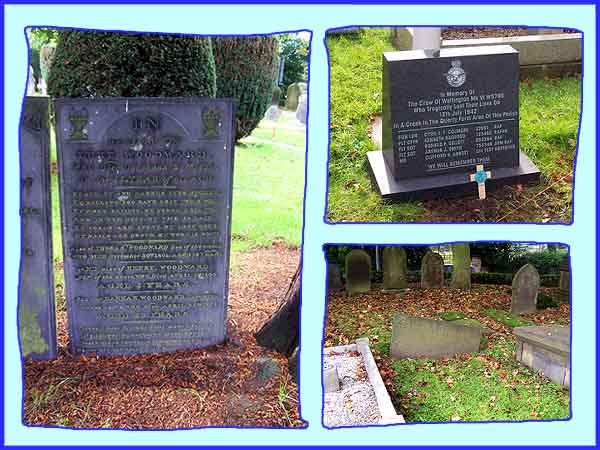
In the churchyard as is to be expected, there are a number of
tombstones and behind many of them there are interesting stories
to be told of bygone village life. For example the epitaph for
the village blacksmith, Luke Woodward who died aged 85 in 1837
reads, "My steady and hammer lyes reclined, My bellows
too have lost their wind, My fire's extinct, my forge decay'd,
And in the dust, my vice is laid. My coal's are spent, my iron
gone; My nails are drove, my work is done." The story
goes that Luke's smithy was at a corner in the village by a small
stream and after shaping his work hot from the forge, he would
dip it in the 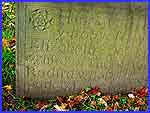 stream
to cool it down. In the same grave lie two sons and a daughter
of Mr Woodward who pre-deceased him aged 19, 5 and 22 in 1801,
1803 and 1822 respectively. stream
to cool it down. In the same grave lie two sons and a daughter
of Mr Woodward who pre-deceased him aged 19, 5 and 22 in 1801,
1803 and 1822 respectively.
The oldest legible tombstone in the churchyard (bottom right
above and this small image on which some of the inscription can
just be made out) is for two members of the Radford family, Elizabeth
and her daughter who both died in 1733. Elizabeth's husband,
Thomas who was a tanner and one of the family of Radfords who
lived across the road at Stanley Hall, died in 1755. His tomb
is next in line.
The third image in the triptych above is not a tombstone at all
but a memorial to the men who lost the lives in the Wellington
Bomber Crash in 1942. The memorial is a recent addition to the
churchyard and was unveiled on Sunday 11th July 2004. The BBC's
People's War contains at least two accounts of the crash here and here. And if you would like to learn more
about the memorials and tombstones in the churchyard Alan Bloor's
excellent Stanley One Place Study website is the place
to look.
|
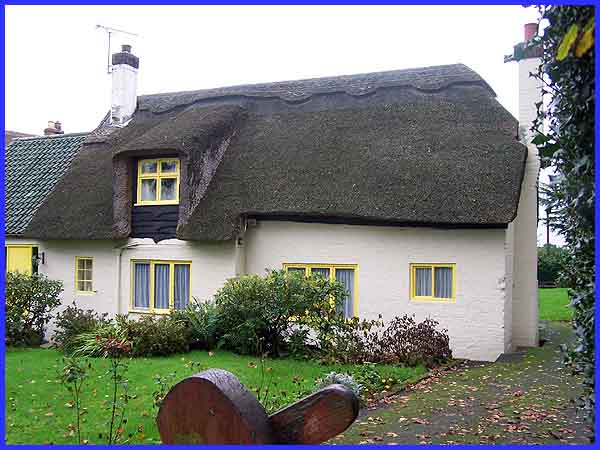
Standing right next to the church is a fifteenth century cruck-framed
cottage. A cruck is one of a pair of naturally curved timbers
that forms one of several rigid arched frames to support the
roof. The frame in this old cottage was discovered during renovation
work when detailed drawings were prepared and lodged with the
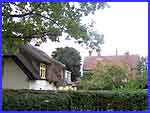 Derbyshire
Archeological Society. The cottage is also worthy of note as
being one of the few thatched buildings to be found in the Borough
of Erewash. Beyond the cottage and seen in this small image from
the churchyard at the rear of the cottage is the old vicarage.
This large house with many rooms and two staircases - one for
the servants and one for the masters - was built in 1872. Derbyshire
Archeological Society. The cottage is also worthy of note as
being one of the few thatched buildings to be found in the Borough
of Erewash. Beyond the cottage and seen in this small image from
the churchyard at the rear of the cottage is the old vicarage.
This large house with many rooms and two staircases - one for
the servants and one for the masters - was built in 1872.
In Part 5 we'll continue our walk through the village beyond
the old vicarage to explore the area that became known locally
as 'Grundy's Corner'.
|

